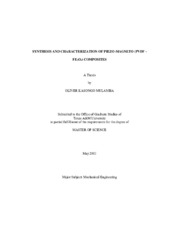| dc.description.abstract | This research entails the synthesis and characterization of a novel class of materials which incorporate both magnetic and piezoelectric characteristics. The composite is made up of the piezoelectric polymer PVDF and magnetic nanoparticles.
The testing samples are produced using a spin casting process. The characterizations of the samples were performed using X-ray diffraction, Atomic force microscopy, linear staging, Dynamic mechanical analysis, Differential scanning calorimetry, and Fourier transform Infra-Red. X-ray diffraction and Atomic force microscopy showed that the presence of the Fe3O4 particles have no effect on the crystallinity of the polymer matrix, therefore allowing for the incorporation of inclusions without directly affecting the piezoelectric property. Changes in the thermal characteristics of the polymer matrix, observed using Differential scanning calorimetry, indicated increases in the thermal conductivity of the composite. Decreases in the heat of melting and crystallization were also observed and further solidified the conclusion that the presence of the Fe3O4 nanoparticles changes the thermal behavior of the polymer. It was observed from the DMA results caused an increase in the storage modulus of the polymer matrix which is related to an increase in the material's ability to store energy. Linear staging results showed that the presence of the nanoparticles had an effect on the mechanical properties of the composites and altered the time dependent voltage output readings. These results were used to calculate the energy capabilities of the composite material and it was found that the composites showed greater energy outputs with increasing amounts of nanoparticles. Interaction was observed between the embedded particles and an external magnetic field, which was found to decrease the energy outputs of the composites.
This research showed enhancements in the composite material's energy outputs in comparison to the pure PVDF samples. This research also showed that the embedded nanoparticles interacted with an exteriorly applied magnetic field. This observation introduces a new dimension of possible activation processes for piezoelectric devices which have been largely based on physical forms of activation. PVDF which is widely used in research and applications for its superior output capabilities has been enhanced in this research and shown to have capabilities to exhibit higher energy outputs. | en |


